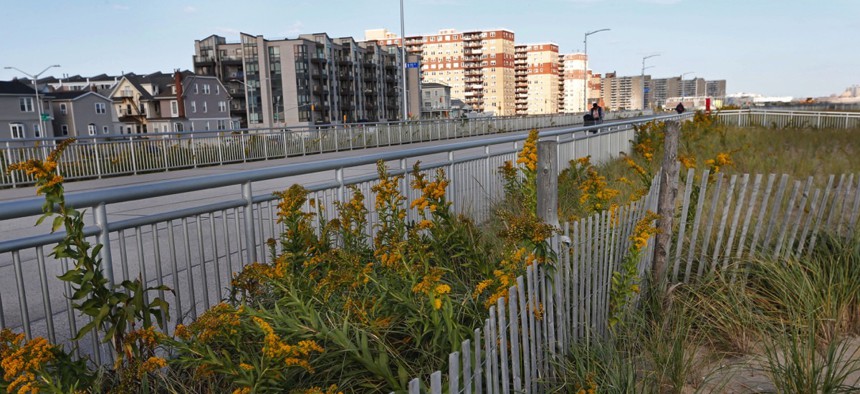Prioritizing Disaster Recovery Projects Through a Social Resilience Lens

Five years after Superstorm Sandy, dune plantings border a broad concrete boardwalk separating residential buildings, left, from the beach in Rockaway Beach in the Queens borough of New York City. Kathy Willens / AP Photo
Fostering social cohesion post-emergency is just as important as rebuilding infrastructure stronger.
The Beach 41st Street Houses community garden in Rockaway, Queens was washed away by Superstorm Sandy in 2012, a hurricane that devastated parts of New York City and other low-lying coastal areas in the mid-Atlantic. Since then, the community garden has been the focus of a social resilience project that’s concluding this year.
Residents of the public housing units had cultivated vegetables and flowers in the garden for two decades, so social scientists with the U.S. Forest Service teamed with Cornell University researchers to rebuild the space.
All the while, they’ve been studying the role nature plays in improving people’s well-being following a disturbance like a hurricane or, in New York City’s recent history, the Sept. 11, 2001, terrorist attacks.
“This was an opportunity for the community to assess, talk and process what happened to them and choose the ways they wanted to reknit their community,” Erika Svendsen, a Forest Service research social scientist,” told Route Fifty by phone.
In that way, the site—with its four midstory towers and large open space—became a microcosm for the recovery process.
Community greening of the garden grounds and its 30 plots was overseen by a squad of landscape designers, artists and local organizers. Flower beds were elevated and filled with salt-tolerant plant, a pergola was handbuilt through a paid woodworking apprenticeship and trash and debris were cleared.
Volunteer organizations like the Rockaway Waterfront Alliance were connected with the city’s Resident Greening Committee to promote neighborhood environmental stewardship.
Often, resilience that involves improving biophysical features like wetlands or dunes to protect coastline and reduce flooding is favored over resilience as a platform for social cohesion.
“It was less hardening and more strengthening the social ties to withstand a storm like this in the future,” said Lindsay Campbell, Forest Service research social scientist. “We didn’t have the budget to reengineer the shoreline.”
Social resilience is a different lens with which to prioritize disaster recovery projects, Svendsen said.
While the Forest Service is wrapping up its presence on the ground, it’s publishing a short documentary by partner the TKF Foundation and a book, “Green Readiness Response, and Recovery: A Collaborative Synthesis,” that will feature the Beach 41st Street Houses among other case studies from across the country.
Officials in Joplin, Missouri worked with New York officials on the project. In 2011, the southwest Missouri city was hit by a tornado that killed 158 people. A garden was developed as a memorial to the lives and tree canopy lost.
“Recovery timelines are long, and people need these sorts of spaces for remembrance,” Campbell said.
Dave Nyczepir is a News Editor at Government Executive’s Route Fifty and is based in Washington, D.C.
NEXT STORY: Innovation and Urban Inequality Go Hand in Hand






